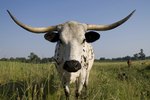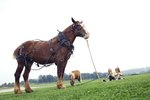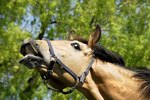If you're looking for a flashy, gaited horse that comes in a variety of colors, consider the Paso Fino. The one color exception is the leopard-coated Appaloosa, which isn't part of the Paso Fino's genetic heritage. Although these horses are relatively small, they can carry great weights. In its native Central and South American countries, the Paso Fino was the preferred breed of large landowners, many of whom were also fairly large people.
History
The Paso Fino's ancestors came from Spain, and this type of horse arrived in the New World with Columbus's second voyage, to what is currently the Dominican Republic. Spanish explorers and conquistadors continued bringing these equines of Andalusian, Barb and Jennet ancestry to the Americas. The latter were a gaited breed, so it is from them that the Paso Fino inherited its distinctive four-beat gait.
Appearance
Paso Finos range in height between 13 to 15.2 hands, so those standing at 14.2 hands or under are technically ponies. At maturity, they weight between 700 and 1,000 pounds but might not reach their full size until the age of 5. No matter what the color, the mane and tail are very full. The neck is arched and carried high, while the head appears quite refined. The Paso Fino's croup -- the top of the hindquarters -- slopes more than other breeds.
Colors
You name the shade, you'll eventually find a Paso Fino in that color. Standard Paso Fino colors include bay, horses with a brown body and black points on the legs, mane and tail; chestnut, various shades of red; and brown, which often appears black except for brown shades on the muzzle, inner thigh and flanks; as well as a true black. You’ll also find grays and pintos, a mix of brown and white or black and white. Roans have a darker base coat mixed with many white hairs.
Everyone knows the golden palomino, with its light mane and tail; and the buckskin, a golden or tan horse with black points. A dun consists of a horse of any color with darker points and a dorsal stripe running down the back. Less common colors include cremello, a very light-colored horse with blue eyes; perlino, similar to a cremello but with darker point shadings; and grulla, a rare slate gray color with dun points and the dorsal stripe.
Gaits
The Paso Fino performs three gaits: the walk, canter and gait. The latter is performed at various speeds and degrees of collection. In the classic fino, the completely collected horse moves his feet rapidly while actually going forward slowly. The paso corto covers ground, at the approximate speed of a trot. The paso largo is very fast, as fast as another breed's gallop. While training enhances these gaits, they are natural to the breed, and even babies do their own version.
References
Resources
Writer Bio
Jane Meggitt has been a writer for more than 20 years. In addition to reporting for a major newspaper chain, she has been published in "Horse News," "Suburban Classic," "Hoof Beats," "Equine Journal" and other publications. She has a Bachelor of Arts in English from New York University and an Associate of Arts from the American Academy of Dramatics Arts, New York City.





